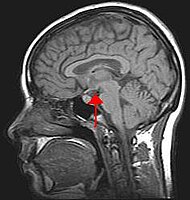
Photo from wikipedia
Nutrient restriction and/or realimentation may affect several placental functions, such as expression of selected regulatory factors, blood flow and other processes in sheep and other species. To determine the effects… Click to show full abstract
Nutrient restriction and/or realimentation may affect several placental functions, such as expression of selected regulatory factors, blood flow and other processes in sheep and other species. To determine the effects of the plane of nutrition, nulliparous white face ewes (6-8 months) carrying singletons on day 50 of gestation were randomly assigned to two dietary treatments receiving 100% of National Research Council recommendations (control; C) or 60% of C (restricted; R). Two groups remained on C or R diets from day 50 until day 130. From day 90-130 another group of C fed ewes was switched to the R diet, and another group of R fed ewes was switched to the C diet. This resulted in 7 groups (n = 5-6 ewes/group): C (day 50, 90 and 130), R (day 90 and 130), CR (day 130) and RC (day 130). At these time points, placental tissues were collected for the evaluation of progesterone receptor (PGR) protein expression (whole tissue), and mRNA expression in maternal (caruncular, CAR) and fetal (cotyledon, COT) (separated tissues). Data were statistically analyzed using analysis of variance (SAS 9.4). Protein for PGRAB and PGRB isoforms was detected using immunohistochemistry in all placental tissues, but the pattern of expression differed depending on pregnancy stage and placental compartment (e.g., CAR vs COT). PGRAB protein expression, quantified using image analysis, was greater (P < 0.04) on day 50 than 90 or 130, and was not affected by plane of nutrition. In CAR and COT, PGRAB mRNA expression was greater (P < 0.05) on day 50 than 90 or 130. PGRB mRNA expression was greater (P < 0.03) in CAR on day 50 than 90 and 130, and was greatest (P < 0.02) in COT on day 50, less on day 130, and least on day 90. For the membrane progesterone receptors, PAQR7 (membrane PGR alpha) mRNA expression was greater (P < 0.05) on days 50 and 90 than 130 in CAR, and greater (P < 0.01) on days 50 than 90 and 130 in COT; PAQR8 (membrane PGR beta) was similar throughout pregnancy in CAR and COT, and PAQR5 (membrane PGR gamma) was greatest (P < 0.0001) on day 130 in COT, but similar throughout pregnancy in CAR. Plane of nutrition affected (P < 0.05) mRNA expression for all genes in CAR and COT throughout pregnancy. These data indicate that expression of PGR in ovine placenta is dependent on stage of pregnancy and plane of nutrition in sheep. The mechanisms of how diet and stage of pregnancy influences placental PGR expression and function remains to be elucidated.
Journal Title: Theriogenology
Year Published: 2020
Link to full text (if available)
Share on Social Media: Sign Up to like & get
recommendations!